
Interactive Tools Guide
Share
Interactive Tools for Measuring Sacred Sites: A Beginner's Guide
Published by Pyramason Team | How-To Guides, Sacred Geometry, Research Tools
Whether you're a curious beginner or an experienced researcher, understanding how to measure and analyze sacred sites can unlock profound insights into ancient wisdom. At Pyramason, we've developed user-friendly tools that make archaeological analysis accessible to everyone. This guide will walk you through the fundamentals of sacred site measurement and show you how to use our interactive platform effectively.
Why Measure Ancient Sites?
Before diving into the how, let's understand the why. Measuring sacred sites reveals:
- Mathematical relationships that suggest sophisticated ancient knowledge
- Astronomical alignments that connect earthbound structures to celestial cycles
- Geometric patterns that appear across cultures and continents
- Construction techniques that challenge our assumptions about ancient capabilities
- Cultural connections between seemingly unrelated civilizations
Essential Concepts for Beginners
Sacred Geometry Basics
The Golden Ratio (φ = 1.618...): Found in nature and ancient architecture, this proportion creates visually pleasing relationships.
Pi (π = 3.14159...): The relationship between circles and their diameters, often encoded in circular or curved structures.
Pythagorean Theorem: The mathematical relationship between right triangle sides, fundamental to ancient construction.
Cardinal Alignments: How structures align with north, south, east, and west directions.
Units of Measurement
Ancient builders used standardized units that we can identify:
Egyptian Royal Cubit: Approximately 20.6 inches (52.5 cm) Mesopotamian Cubit: About 19.8 inches (50.3 cm)
Megalithic Yard: Roughly 32.64 inches (82.9 cm) Greek Stadium: Approximately 600 feet (185 meters)
Getting Started with Pyramason's Tools
Step 1: Choose Your Site
Our interactive map contains thousands of catalogued ancient sites. Start with well-documented locations like:
- The Great Pyramid of Giza (excellent for learning basic measurements)
- Stonehenge (perfect for understanding circular geometry)
- Angkor Wat (ideal for complex geometric relationships)
- Teotihuacan (great for urban planning analysis)
Step 2: Basic Measurements
Length and Width Analysis:
- Select the measurement tool from our toolbar
- Click and drag to measure structure dimensions
- Record your measurements for pattern analysis
- Compare ratios between different dimensions
Angle Measurements:
- Use the angle tool to measure structural alignments
- Check alignments against cardinal directions
- Analyze geometric relationships between different elements
- Document any astronomical alignments
Step 3: Ratio Analysis
Golden Ratio Detection:
- Divide longer measurements by shorter ones
- Look for results near 1.618
- Check diagonal relationships in rectangular structures
- Analyze height-to-base ratios in pyramidal structures
Musical Interval Ratios:
- Calculate ratios like 3:2, 4:3, and 5:4
- These mathematical relationships appear in both music and architecture
- Often found in chamber dimensions and structural proportions
Advanced Analysis Techniques
Overlay Patterns
Use our geometric overlay tools to:
- Apply golden spirals to circular or curved structures
- Add triangular grids to identify hidden geometric relationships
- Overlay star maps to check astronomical alignments
- Compare site layouts using standardized geometric templates
Multi-Site Comparisons
Distance Analysis:
- Measure distances between related sites
- Look for patterns in site placement
- Check for mathematical relationships in spacing
- Investigate potential ley line connections
Proportional Analysis:
- Compare dimension ratios across different sites
- Identify common geometric principles
- Look for standardized measurement units
- Document cultural transmission of knowledge
Practical Measurement Tips
Accuracy Best Practices
Use Multiple Reference Points: Always cross-check measurements using different reference markers.
Account for Erosion: Consider how weather and time might have altered original dimensions.
Verify with Multiple Sources: Compare your measurements with published archaeological data.
Document Everything: Keep detailed records of your measurements and methodologies.
Common Beginner Mistakes
Ignoring Measurement Units: Always consider what unit system the original builders might have used.
Over-interpreting Coincidences: Not every numerical relationship indicates intentional design.
Neglecting Archaeological Context: Measurements should support, not replace, historical evidence.
Rushing Analysis: Take time to understand what you're measuring before drawing conclusions.
Tools and Features Guide
Free Analysis Tools
Basic Measurement Suite:
- Length, width, and area calculations
- Simple angle measurements
- Basic ratio analysis
- Cardinal direction alignment checks
Community Features:
- Share measurements with other researchers
- Comment on findings and theories
- Access community-verified data
- Participate in group analysis projects
Premium Research Features
Advanced Analysis Suite:
- Precision astronomical alignment tools
- Complex geometric overlay systems
- Multi-site comparative analysis
- Historical measurement unit conversions
Data Export Options:
- Download measurement data for external analysis
- Generate professional analysis reports
- Access raw measurement databases
- Create custom measurement templates
Building Your Research Skills
Start Small, Think Big
Begin with simple measurements on well-documented sites, then gradually tackle more complex analysis as your skills develop. Each measurement you take contributes to our growing understanding of ancient wisdom.
Join the Community
Connect with other researchers through our platform:
- Share your discoveries and theories
- Learn from experienced archaeologists and enthusiasts
- Collaborate on large-scale analysis projects
- Contribute to our expanding database of measurements
Continuous Learning
Stay Updated: New archaeological discoveries regularly provide fresh insights into ancient measurement techniques.
Cross-Reference: Always compare your findings with published archaeological research.
Experiment: Try different measurement approaches and analytical techniques.
Document: Keep detailed records of your methodologies and findings.
Making Your Mark
Every measurement matters. Whether you're verifying existing theories or discovering new patterns, your contributions help build our collective understanding of ancient wisdom. The tools we provide are only as powerful as the community that uses them.
Remember: the ancient builders who created these magnificent structures were real people solving real problems with sophisticated mathematical knowledge. By measuring their work, we're not just studying the past—we're learning principles that remain relevant today.
Ready to start measuring? Access our interactive analysis tools and begin your journey into the mathematical mysteries of the ancient world. And remember, when you support Pyramason through our apparel collections, you're directly funding the development of these free research tools.
What's your first measurement going to be? Share your analysis plans and connect with fellow researchers in our community.
